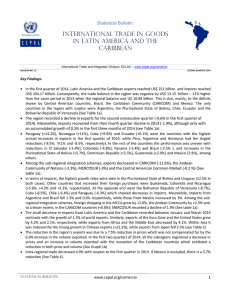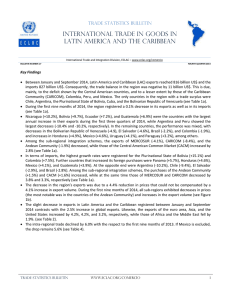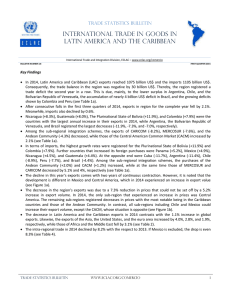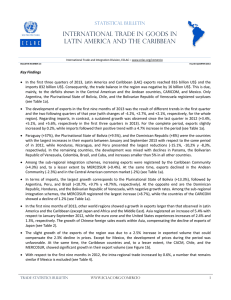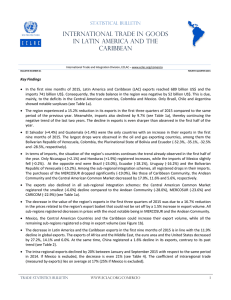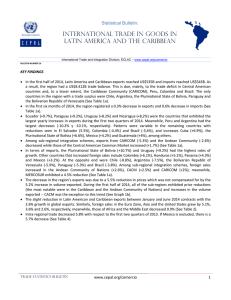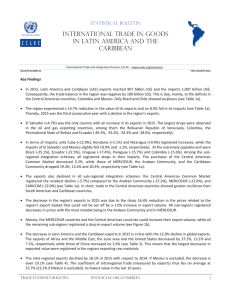bulletin_first_quarter_2014_no14 PDF | 962.1 Kb
Anuncio
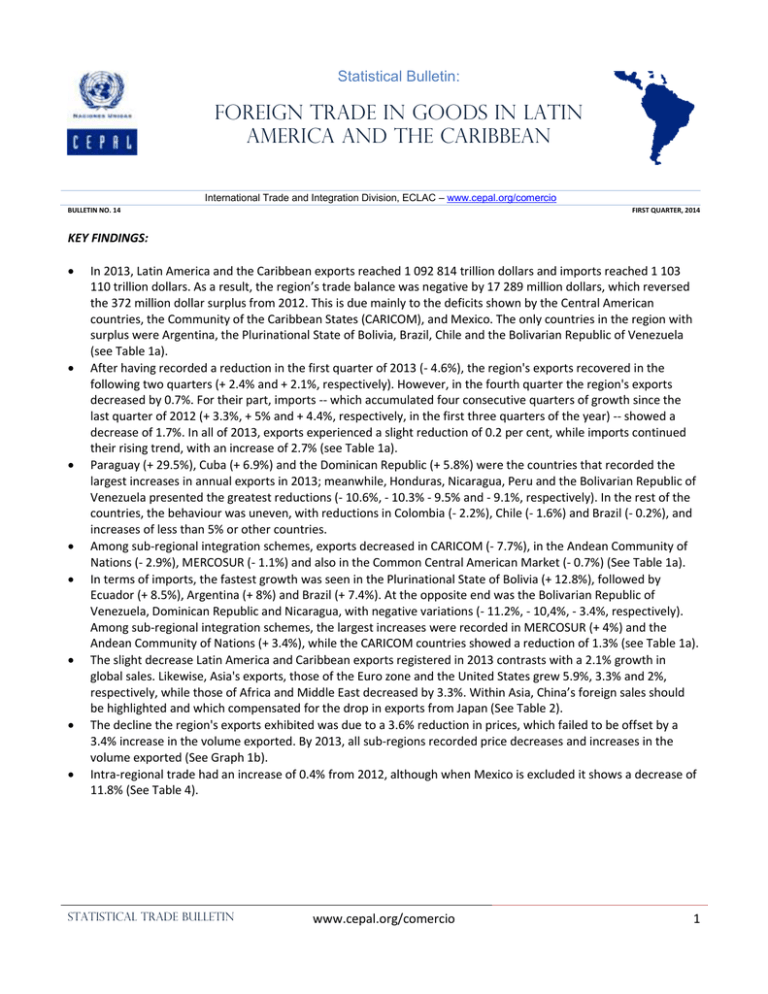
Statistical Bulletin: FOREIGN TRADE IN GOODS IN LATIN AMERICA AND THE CARIBBEAN International Trade and Integration Division, ECLAC – www.cepal.org/comercio BULLETIN NO. 14 FIRST QUARTER, 2014 KEY FINDINGS: In 2013, Latin America and the Caribbean exports reached 1 092 814 trillion dollars and imports reached 1 103 110 trillion dollars. As a result, the region’s trade balance was negative by 17 289 million dollars, which reversed the 372 million dollar surplus from 2012. This is due mainly to the deficits shown by the Central American countries, the Community of the Caribbean States (CARICOM), and Mexico. The only countries in the region with surplus were Argentina, the Plurinational State of Bolivia, Brazil, Chile and the Bolivarian Republic of Venezuela (see Table 1a). After having recorded a reduction in the first quarter of 2013 (- 4.6%), the region's exports recovered in the following two quarters (+ 2.4% and + 2.1%, respectively). However, in the fourth quarter the region's exports decreased by 0.7%. For their part, imports -- which accumulated four consecutive quarters of growth since the last quarter of 2012 (+ 3.3%, + 5% and + 4.4%, respectively, in the first three quarters of the year) -- showed a decrease of 1.7%. In all of 2013, exports experienced a slight reduction of 0.2 per cent, while imports continued their rising trend, with an increase of 2.7% (see Table 1a). Paraguay (+ 29.5%), Cuba (+ 6.9%) and the Dominican Republic (+ 5.8%) were the countries that recorded the largest increases in annual exports in 2013; meanwhile, Honduras, Nicaragua, Peru and the Bolivarian Republic of Venezuela presented the greatest reductions (- 10.6%, - 10.3% - 9.5% and - 9.1%, respectively). In the rest of the countries, the behaviour was uneven, with reductions in Colombia (- 2.2%), Chile (- 1.6%) and Brazil (- 0.2%), and increases of less than 5% or other countries. Among sub-regional integration schemes, exports decreased in CARICOM (- 7.7%), in the Andean Community of Nations (- 2.9%), MERCOSUR (- 1.1%) and also in the Common Central American Market (- 0.7%) (See Table 1a). In terms of imports, the fastest growth was seen in the Plurinational State of Bolivia (+ 12.8%), followed by Ecuador (+ 8.5%), Argentina (+ 8%) and Brazil (+ 7.4%). At the opposite end was the Bolivarian Republic of Venezuela, Dominican Republic and Nicaragua, with negative variations (- 11.2%, - 10,4%, - 3.4%, respectively). Among sub-regional integration schemes, the largest increases were recorded in MERCOSUR (+ 4%) and the Andean Community of Nations (+ 3.4%), while the CARICOM countries showed a reduction of 1.3% (see Table 1a). The slight decrease Latin America and Caribbean exports registered in 2013 contrasts with a 2.1% growth in global sales. Likewise, Asia's exports, those of the Euro zone and the United States grew 5.9%, 3.3% and 2%, respectively, while those of Africa and Middle East decreased by 3.3%. Within Asia, China’s foreign sales should be highlighted and which compensated for the drop in exports from Japan (See Table 2). The decline the region's exports exhibited was due to a 3.6% reduction in prices, which failed to be offset by a 3.4% increase in the volume exported. By 2013, all sub-regions recorded price decreases and increases in the volume exported (See Graph 1b). Intra-regional trade had an increase of 0.4% from 2012, although when Mexico is excluded it shows a decrease of 11.8% (See Table 4). STATISTICAL TRADE BULLETIN www.cepal.org/comercio 1 A – Trade by origin and destination Box 1: Latin America and the Caribbean: Trends in foreign trade in goods (Millions of current dollars and variation rates in percentages) a) Cumulative from January to December Argentina Bolivia, Plur. St. of Brazil Chile Colombia Costa Rica Cuba Ecuador El Salvador Guatemala Honduras Mexico Nicaragua Panama Paraguay Peru Dominican Republic Uruguay Venezuela, Bol. Rep. of Latin America and the Caribbean Andean Community of Nations (ACN) Caribbean Community (CARICOM) Central American Common Market (MCCA) Southern Common Market (MERCOSUR) Exports 83 026 12 043 242 179 76 684 58 822 11 405 2 490 24 958 5 491 10 162 3 953 380 189 2 401 844 9 432 41 826 9 595 9 056 88 481 1 092 814 137 648 19 778 33 411 432 174 2013 Imports 74 002 8 676 239 621 74 568 59 381 18 008 8 861 27 305 10 772 17 510 9 108 381 210 5 650 13 096 11 302 42 191 13 406 11 642 58 062 1 110 103 137 553 25 733 61 047 394 629 Variation Balance 9 024 3 367 2 558 2 117 - 559 -6 603 -6 371 -2 347 -5 281 -7 348 -5 156 -1 022 -3 249 -12 253 -1 870 - 365 -3 811 -2 586 30 419 -17 289 96 -5 955 -27 636 37 545 Exports Imports 2,6 4,4 -0,2 -1,6 -2,2 1,4 6,9 4,5 2,8 1,8 -10,6 2,6 -10,3 2,7 29,5 -9,5 5,8 4,0 -9,1 -0,2 -2,9 -7,7 -0,7 -1,1 8,0 12,8 7,4 -1,2 0,5 2,4 1,7 8,5 4,9 3,0 -3,0 2,8 -3,4 3,7 5,1 2,6 -10,4 -0,1 -11,2 2,7 3,4 -1,3 1,6 4,0 b) Exports from January 2013 to December 2013 Argentina Bolivia, Plur. St. of Brazil Chile Colombia Costa Rica Cuba Ecuador El Salvador Guatemala Honduras Mexico Nicaragua Panama Paraguay Peru Dominican Republic Uruguay Venezuela, Bol. Rep. of Latin America and the Caribbean ACN CARICOM CACM MERCOSUR Jan-13 5 665 1 124 15 967 6 855 4 849 897 195 1 939 478 828 380 27 299 217 68 649 3 434 700 537 7 934 81 944 Feb-13 5 743 824 15 549 5 621 4 668 919 165 2 082 436 796 358 29 146 188 64 746 3 204 736 527 6 922 80 230 Mar-13 5 968 1 054 19 320 6 217 4 618 986 125 2 201 448 982 381 31 881 222 66 838 3 637 819 612 7 408 89 615 Apr-13 7 565 1 008 20 631 6 766 4 949 989 218 1 934 489 888 355 32 861 231 71 918 3 201 824 713 7 859 94 290 May-13 8 429 1 015 21 822 7 011 5 332 999 206 2 055 520 966 353 32 836 208 75 976 3 523 927 988 6 986 96 865 Jun-13 7 551 1 008 21 134 6 341 4 871 961 192 1 983 451 808 320 31 025 197 62 920 3 279 776 1 002 7 540 92 101 Jul-13 7 828 1 046 20 807 6 338 4 652 947 275 2 130 491 827 308 32 212 196 80 908 3 366 857 885 7 124 93 011 Aug-13 7 735 1 047 21 424 6 377 4 978 927 177 2 102 478 805 288 32 668 191 76 924 4 141 826 934 7 671 95 524 Sep-13 6 995 1 005 20 996 5 812 4 850 969 225 2 195 425 733 290 31 385 182 77 697 3 613 782 803 7 435 90 873 Oct-13 7 271 1 084 22 821 7 025 4 838 999 275 2 124 450 762 270 35 088 202 76 658 3 539 782 673 7 090 97 569 Nov-13 6 829 905 20 861 6 115 4 944 956 220 2 025 400 835 289 31 703 190 70 661 3 257 782 655 7 481 90 609 Dec-13 5 447 923 20 846 6 208 5 272 855 217 2 186 425 932 359 32 086 179 60 538 3 633 782 728 7 029 90 184 11 346 1 929 2 800 30 751 10 777 1 536 2 698 29 487 11 510 1 833 3 019 34 145 11 093 1 819 2 952 37 686 11 925 1 639 3 045 39 202 11 140 1 680 2 738 38 147 11 194 1 735 2 769 37 552 12 267 1 754 2 689 38 689 11 663 1 404 2 599 36 927 11 585 1 540 2 683 38 513 11 132 1 430 2 670 36 487 12 014 1 478 2 751 34 588 STATISTICAL TRADE BULLETIN www.cepal.org/comercio 2 c) Imports from January 2013 to December 2013 Jan-13 5 385 706 20 007 6 637 5 185 1 563 724 2 281 915 1 465 807 30 153 426 1 126 1 004 3 761 1 022 895 5 769 91 798 Feb-13 5 222 567 16 828 5 781 4 497 1 354 744 2 123 802 1 337 726 29 066 460 902 884 3 184 1 182 839 4 893 83 595 Mar-13 5 458 688 19 158 5 702 4 488 1 474 740 2 214 825 1 346 679 30 128 402 1 080 873 3 280 1 103 916 5 139 87 949 Apr-13 6 414 710 21 620 6 388 5 167 1 606 750 2 249 947 1 610 738 34 088 493 1 027 1 056 3 526 1 102 992 4 127 96 649 May-13 7 091 735 21 061 6 685 5 181 1 488 757 2 499 957 1 596 714 33 306 466 1 203 936 3 794 1 141 1 018 3 392 95 947 Jun-13 6 396 576 18 826 5 768 4 311 1 392 778 2 228 961 1 382 710 30 168 479 1 069 828 3 207 1 160 828 7 121 90 418 Jul-13 7 058 709 22 706 6 539 5 112 1 538 733 2 277 967 1 532 804 33 651 491 1 112 923 3 761 1 184 988 4 194 98 270 Aug-13 7 167 798 20 201 6 689 4 975 1 525 697 2 550 934 1 387 767 32 902 510 1 115 965 3 951 1 177 1 011 4 229 95 874 Sep-13 6 146 691 18 855 5 803 5 148 1 502 709 2 199 831 1 474 733 30 726 445 960 966 3 418 1 084 1 129 4 799 89 929 Oct-13 6 561 831 23 046 6 695 5 348 1 609 730 2 454 942 1 605 798 35 217 495 1 297 991 3 767 1 084 1 105 4 826 101 446 Nov-13 5 929 777 19 122 5 674 5 033 1 532 725 2 207 895 1 443 807 31 364 476 1 102 922 3 388 1 084 982 4 846 90 444 Dec-13 5 175 888 18 192 6 207 4 935 1 425 774 2 023 796 1 333 824 30 441 506 1 102 952 3 153 1 084 941 4 728 87 784 CACM 11 934 1 966 5 176 10 371 2 204 4 679 10 669 2 258 4 726 11 653 2 040 5 394 12 209 1 927 5 222 10 323 2 229 4 925 11 859 1 990 5 333 12 273 2 325 5 123 11 456 2 311 4 984 12 401 2 044 5 449 11 405 2 135 5 153 10 999 2 305 4 885 MERCOSUR 33 060 28 666 31 543 34 208 33 497 34 000 35 868 33 573 31 895 36 529 31 801 29 988 Argentina Bolivia, Plur. St. of Brazil Chile Colombia Costa Rica Cuba Ecuador El Salvador Guatemala Honduras Mexico Nicaragua Panama Paraguay Peru Dominican Republic Uruguay Venezuela, Bol. Rep. of Latin America and the Cairbbean ACN CARICOM Source: ECLAC based on data from Statistics Institutes, Central Banks, Export Promotion Agencies, the United States International Trade Commission, the EU EUROSTAT, Statistics Canada, International Monetary Fund Direction of Trade Statistics (DOTS) and the Central American Monetary Council. Notes: Data for the Bolivarian Republic of Venezuela are quarterly and the monthly DOTS trends were applied. Data for Cuba and the CARICOM countries are estimated based on mirror statistics. Data for Honduras and Nicaragua does not include maquila. For the Dominican Republic and the Bolivarian Republic of Venezuela, data for the time period between October and December are estimated. MERCOSUR data includes the Bolivarian Republic of Venezuela. Graph 1: Latin America and the Caribbean: Trends in Exports, January to December 2013 a) Rate of variation compared to the previous year -1,9 Caribbean countries Mexico CACM -0,7 Chile -1,6 -4,3 -2,9 Andean countries -1,1 -2,6 -1,5 -1,1 -0,2 MERCOSUR South America Latin America and the Caribbean -25 b) Detail of growth in price and volume in comparison to the previous year Caribbean countries 11,3 2,6 6,1 Mexico 4,0 CACM -5,7 -0,3 10,9 3,7 Andean countries -4,1 South America 3,0 -4,8 Latin America and the Caribbean 0 Jan-Dic 2013/Jan-Dic 2012 -5,3 -6,9 4,0 MERCOSUR 1,7 2,9 -11,7 Chile 5,8 3,8 3,3 -3,6 3,4 25 -25 0 Price 25 Volume Source: ECLAC based on data from Statistics Institutes, Central Banks, Export Promotion Agencies, the United States International Trade Commission, the EU EUROSTAT, Statistics Canada, International Monetary Fund Direction of Trade Statistics (DOTS) and the Central American Monetary Council Notes: Data for the Bolivarian Republic of Venezuela are quarterly and the monthly DOTS trends were applied. Data for countries in the Caribbean (Cuba and CARICOM) were estimated using mirror statistics. Cuba’s deflator is built based on the volume imported by the European Union; the Caribbean’s deflator is built based on the deflators reported by Guyana and Jamaica to the International Monetary Fund. CACM statistics do not include maquila from Honduras or Nicaragua. MERCOSUR data includes the Bolivarian Republic of Venezuela. As mentioned previously, in 2013 the region's exports declined 0.2% as a result of a 3.6% reduction in prices, which failed to be compensated by the 3.4% increase of the volume exported. All sub-regions decreased in the recorded price and increases in the volume exported. The largest price reductions were seen in CACM (- 11.7%) and the Andean Community (- 6.9%), while the largest increases in volume were also observed in CACM (+ 10.9%) and the Andean countries (+ 4%) (See Graph 1b). STATISTICAL TRADE BULLETIN www.cepal.org/comercio 3 Graph 2 and Table 1. Latin America and the Caribbean and Selection Regions: Trends in export values, January 2006 to December 2013 Latin American and Caribbean exports: Main destinations (January index 2006=100) Changes compared to other regions in the world (Accumulated to December of each year, in percentages) 1200 1000 Latin America and the Caribbean Africa and the Middle East Asia China Japan United States Euro Zone World 800 600 400 200 Jan-06 May-06 Sep-06 Jan-07 May-07 Sep-07 Jan-08 May-08 Sep-08 Jan-09 May-09 Sep-09 Jan-10 May-10 Sep-10 Jan-11 May-11 Sep-11 Jan-12 May-12 Sep-12 Jan-13 May-13 Sep-13 0 United States China Latin America and the Caribbean 2011 Variation 23,7 2012 Variation 1,7 2013 Variation -0,2 29,3 19,0 20,3 7,0 15,8 17,1 19,4 0,9 3,2 7,9 -2,6 4,7 -4,5 -0,3 -3,3 5,9 7,6 -10,4 2,0 3,3 2,1 European Union Rest of Asia Source: ECLAC based on data from Statistics Institutes, Central Banks, Export Promotion Agencies, the United States International Trade Commission, the EU EUROSTAT, Statistics Canada, International Monetary Fund Direction of Trade Statistics (DOTS) and CPB Netherlands Bureau for Economic Policy Analysis. Notes: Data for the Bolivarian Republic of Venezuela are quarterly and the monthly DOTS trends were applied. Data for Cuba and the CARICOM countries are estimated based on mirror statistics. Graph 2 does not include Panama, the Dominican Republic; it also does not include maquila for Honduras and Nicaragua. In 2013, the main destinations for Latin America and the Caribbean exports were the United States (39.8%), Asia (19.5%) and the region itself (18.5%). In the case of imports, the United States was also the main provider (30.3%), followed by Asia (27.2%) and the region itself (18.6%) (See Table 3). Table 2. Latin America and the Caribbean: Trade by main partners, January to December 2013 (Millions of current dollars) Exports United States European Union Asia China Rest of Asia Latin America and the Caribbean Rest of the World Jan-13 81 176 33 426 9 739 13 825 6 243 7 583 14 970 9 216 Feb-13 79 430 32 715 9 403 13 787 5 588 8 198 15 120 8 405 Mar-13 88 730 35 720 9 997 17 062 8 218 8 844 15 970 9 981 Apr-13 93 395 37 575 10 902 18 377 9 538 8 839 16 438 10 102 May-13 95 863 36 961 10 996 21 059 11 557 9 502 17 561 9 287 Jun-13 91 263 35 163 10 286 18 865 9 816 9 049 17 835 9 114 Jul-13 92 074 36 930 11 044 18 263 8 421 9 842 16 855 8 981 Aug-13 94 622 36 834 11 222 19 837 10 453 9 385 17 131 9 598 Sep-13 90 014 34 571 10 902 18 252 9 349 8 903 17 166 9 123 Oct-13 96 710 39 616 12 489 17 858 8 593 9 264 17 827 8 919 Nov-13 89 756 35 013 9 837 16 516 8 555 7 961 18 670 9 721 Dec-13 Part. % 89 342 100,0 36 489 39,8 9 652 11,7 16 976 19,5 8 759 9,7 8 217 9,8 16 530 18,5 9 695 10,5 Imports 89 650 81 511 85 766 94 520 93 603 88 190 95 974 93 581 87 885 99 065 88 258 85 598 100,0 United States 27 495 25 243 27 028 28 976 27 742 25 440 27 985 28 459 26 775 29 510 27 124 26 574 30,3 European Union 12 875 11 193 12 426 14 020 14 112 12 605 13 938 13 958 12 336 13 788 12 866 11 881 14,4 Asia 24 327 22 002 21 953 24 859 25 403 23 403 26 912 25 956 24 532 28 466 24 035 23 410 27,2 China 13 421 12 374 11 867 12 776 13 593 12 775 14 968 14 662 14 366 16 366 13 607 13 342 15,1 Rest of Asia 10 906 9 628 10 086 12 083 11 810 10 628 11 944 11 294 10 165 12 100 10 428 10 067 12,2 Latin America and the Caribbean 16 418 15 530 15 918 17 864 17 891 16 238 17 133 17 511 16 659 17 879 16 124 15 394 18,6 Rest of the World 8 535 7 542 8 441 8 801 8 454 10 504 10 006 7 697 7 583 9 420 8 109 8 339 9,5 Source: ECLAC based on Statistical Institutes, Central Banks, Export Promotion Agencies, the United States International Trade Commission, EU EUROSTAT, Statistics Canada and the International Monetary Fund Division of Trade Statistics (DOTS). Notes: Includes data for Argentina, the Plurinational State of Bolivia, Brazil, Chile, Colombia, Costa Rica, Cuba, Ecuador, El Salvador, Guatemala, Honduras, Mexico, Nicaragua, Paraguay, Peru, Uruguay, Bolivarian Republic of Venezuela and CARICOM. It does not include maquila from Honduras or Nicaragua. Data for Cuba and CARICOM are estimated using mirror statistics from the United States, the European Union, Canada and the rest of Latin America. In the case of the Bolivarian Republic of Venezuela, the total was disaggregated utilizing mirror statistics from the United States, the European Union, Chile, Colombia and Japan; the DOTS structure was used for the reamining destinations. With regard to 2012, regional exports to the European Union and United States declined 3.7% and 0.4%, respectively. Regional sales to Asia continued with the same dynamism registered since the end of 2012 and increased 5.1%; shipments within the region increased by 0.4%. Moreover, the most dynamic imports were from the EU (+ 6.4%) and Asia (+ 4.5%). STATISTICAL TRADE BULLETIN www.cepal.org/comercio 4 Box 4: Latin America: Intra-subregional and sub-regional trade, January to December 2013 (Percentages of total exports and rates of growth) Jan-13 6,3 22,4 14,5 16,4 6,6 18,4 19,9 Feb-13 8,1 23,4 15,4 15,9 6,8 19,0 20,4 Mar-13 7,6 21,1 13,8 18,0 7,4 18,0 18,5 Apr-13 8,0 21,7 13,7 16,2 7,3 17,6 17,9 May-13 7,1 22,9 13,6 18,1 7,5 18,3 18,7 Jun-13 7,4 23,9 12,9 18,4 7,7 19,5 20,3 Jul-13 7,9 24,3 14,2 19,2 7,6 18,3 24,1 Aug-13 6,1 23,7 13,7 19,3 7,9 18,1 23,5 Sep-13 7,7 25,5 14,6 18,5 7,7 19,1 25,1 Oct-13 7,7 25,1 15,3 18,5 7,1 18,4 24,9 Nov-13 6,8 25,8 15,9 20,2 6,8 20,8 28,5 Var. a Dec-13 2013/2012 6,4 -2,7 22,6 6,9 14,9 7,0 16,6 0,3 5,8 -3,1 18,5 0,4 25,6 0,1 Intra-CAN Intra-CACM Intra-MERCOSUR Chile to LAC Mexico to LAC Intra-LAC Intra-LAC w/o Mexico Source: ECLAC based on data from Statistics Institutes, Central Banks, Export Promotion Agencies, the United States International Trade Commission, the EU EUROSTAT, International Monetary Fund Direction of Trade Statistics (DOTS) Notes: (a) Rates of variation with respect to the same period the previous year. It does not include maquila for Honduras or Nicaragua. Data for MERCOSUR includes the Bolivarian Republic of Venezuela. Through December 2013, the Central American Common Market registered the highest share of intra-sub-regional trade (22.6%) -- the only sub-region whose coefficient is situated above the level reached collectively by all the Latin America and the Caribbean countries (18.5%). The Andean community continues to be the country grouping with the lowest coefficient of intra-subregional trade (6.4%). The negative variations recorded by intra-CAN trade and exports from Mexico to the region should be highlighted. These contrast with the dynamism of intra-CACM and intraMERCOSUR exports (See Table 4). While intraregional trade grew at a rate of 0.4%, the region’s exports fell 0.2%. B – Trade by categories and main products Box 3. Latin America and the Caribbean: Main categories of traded products, January to December 2013 (Millions of current dollars) EXPORTS Agriculture and livestock Mining and petroleum Manufactures Jan-13 78 974 11 106 26 208 41 660 Feb-13 78 838 10 115 25 375 43 348 Mar-13 87 497 11 205 26 578 49 714 Apr-13 91 644 12 323 26 597 52 724 May-13 95 084 12 301 27 670 55 112 Jun-13 89 981 10 794 26 194 52 993 Jul-13 91 048 10 962 26 730 53 356 Aug-13 93 031 11 359 27 893 53 779 Sep-13 88 938 10 052 28 081 50 805 Oct-13 Nov-13 87 745 80 538 10 461 9 997 21 234 19 735 56 050 50 806 Dec-13 Part. % 80 460 100.0 10 082 12.5 21 990 29.2 48 388 58.3 IMPORTS 88 306 80 594 84 720 94 324 94 486 84 887 95 610 92 835 86 363 93 855 82 852 78 741 100.0 Capital goods 17 002 14 982 15 427 16 827 16 924 15 334 16 984 16 260 15 117 16 893 15 593 15 433 18.2 Intermediate goods 40 937 39 295 40 704 45 103 46 225 41 875 46 605 45 834 43 159 46 812 41 277 38 319 48.8 Consumer goods 16 549 15 241 16 567 18 084 17 195 16 078 17 964 18 250 17 312 18 656 16 348 15 184 19.2 Fuels 13 818 11 076 12 021 14 310 14 143 11 600 14 058 12 490 10 775 11 494 9 633 9 805 13.7 Source: ECLAC based on data from Statistics Institutes, Central Banks, Export Promotion Agencies, the United States International Trade Commission and the EU EUROSTAT. Notes: Includes data for Argentina, the Plurinational State of Bolivia, Chile, Colombia, Costa Rica, Ecuador, El Salvador, Guatemala, Honduras, Mexico, Nicaragua, Panama, Paraguay, Peru, the Dominican Republic, Uruguay and the Bolivarian Republic of Venezuela. It does not include maquila from Honduras or Nicaragua. Compared to 2012, by product categories, major variations were registered in exports of the group of products related to mining and petroleum (decreased by 13.1%) and agricultural products (which increased 3.7%). For its part, manufacturing - which continues to make up most of the region’s exports - recorded an increase of 2.7%. The decrease of the value exported is due mainly to mineral and petroleum prices, which jointly represent almost 30% of total exports. Likewise, in 2013, the Latin American commodity price index dropped 3% (See Table 6.b), with declines in most of the products (especially beverages and sugar). In terms of the volume exported, gas and iron experienced heavy decreases while soybeans, bananas, and sugar increased (See Table 6a). STATISTICAL TRADE BULLETIN www.cepal.org/comercio 5 Box 6. Latin America and the Caribbean: Main products exported, 2012 y 2013 (Millions of current dollars, percentages and price indexes 2000=100) a) Selected products b) Product groups Valor Products Sugar Banana Beverages (A) Meats Copper Gas Iron-Steel (B) Petroleum Soy (C) Subtotal (D) 2% 1% 3% 2% 9% 2% 5% 30% 3% 57% 2012 15 642 3 627 11 126 22 515 56 391 7 622 16 778 179 287 23 898 336 886 2013 15 193 4 080 8 719 24 192 53 058 8 179 14 383 149 054 31 695 308 552 Precios Variation in value -2,9 12,5 -21,6 7,4 -5,9 7,3 -14,3 -16,9 32,6 -8,4 Dec 2013 202,4 220,6 110,3 211,8 397,2 98,3 490,7 393,2 268,1 203,9 2012 263,4 234,6 170,5 214,1 438,5 63,9 464,5 391,4 279,2 208,9 2013 216,3 220,8 124,9 209,1 404,0 86,5 489,2 387,9 257,2 203,0 Variation Variation in volume in prices -17,9 15,0 -5,9 18,4 -26,7 5,1 -2,3 9,8 -7,8 1,9 35,4 -28,1 5,3 -19,6 -0,9 -16,0 -7,9 40,5 -2,8 -5,6 Prices 170,9 170,5 Variation in prices 166,8 -2,4 124,9 -26,7 9% 217,4 150,7 207,5 152,4 -4,6 209,6 1,2 153,8 27% 246,6 238,5 -3,3 234,5 45% 180,1 176,9 -1,8 176,5 100% 197,0 191,1 -3,0 189,8 (E) Food Beverages Oils and meals Other agro Minerals and Metals Fuels Total 10% 3% 8% 2012 2013 Dec 2013 166,9 110,3 Source: ECLAC based on data from Statistics Institutes, Central Banks, Export Promotion Agencies, CEPALSTAT and the World Bank. See description in the Excel spreadsheet in the Annex. Notes: Product statistics are made up by main exporters in the region and not with all countries; in each case, they represent more than 70% of the annual total for the region in that product. In the case of prices, it is an index calculated by ECLAC. (A) Average of coffee, tea and yerba mate; (B) Made up of iron and steel manufactures; (C) Soy grains; (D) Weight of each product in the total regional exports; (E) Weight of each group in total natural resources and manufacturing exports in the region. Recent Works by the International Trade and Integration Division Publications Latin America's emergence in global services Promoción del comercio y la inversión con China: desafíos y oportunidades en la experiencia de las cámaras empresariales latinoamericanas La cooperación entre América Latina y la Unión Europea: una asociación para el desarrollo Panorama de la inserción internacional de América Latina y el Caribe 2013 Strengthening biregional cooperation between Latin America and Asia-Pacific: the role of FEALAC Comercio internacional y desarrollo inclusivo. Construyendo sinergias Documento de discusión para el seminario Cooperación para el desarrollo CELAC-Unión Europea: Desafíos post 2015 Huella de carbono y exportaciones de alimentos. Guía práctica Panorama de la inserción internacional de América Latina y el Caribe 2011-2012 La República Popular China y América Latina y el Caribe: Diálogo y cooperación ante los nuevos desafíos de la economía global China y América Latina y el Caribe Hacia una relación económica y comercial estratégica Effects of trade opening on household welfare: the Chilean case El pilar de cooperación en el acuerdo de asociación política, económica y de cooperación entre Chile y la Unión Europea India and Latin America and the Caribbean. Opportunities and challenges in trade and investment relations Manual de comercio exterior y política comercial. Nociones básicas, clasificaciones e indicadores de posición y dinamismo Events Taller de Indicadores de Comercio Exterior y Política Comercial TALLER REGIONAL: "Bases de datos para identificar y caracterizar a las pymes exportadoras" Seminario: "La asociación estratégica entre la Unión Europea y América Latina" Reunión de Expertos: "Facilitando la efectiva integración de países en desarrollo en la economía global a través de programas de Ayuda para el Comercio" Seminario internacional: "Cadenas de valor globales y regionales: experiencias Asia y América Latina" Diálogo regional sobre la promoción del desarrollo y el comercio de servicios en América Latina y el Caribe Seminario internacional: "Facilitando la efectiva integración de los países en desarrollo a la Economía Global a través de Programas de Ayuda para el Comercio" Seminario "Competitividad y Cadenas de Valor en América Latina" Seminario "Semana Asia" Taller de Huella de Carbono para productos de exportación, sector alimentos, de América Latina: prácticas empresariales Curso Indicadores de Comercio Exterior y Política Comercial Seminario "Haciendo negocios con China: Experiencias de América Latina" This document, which has not been submitted to formal editing, was prepared by the International Trade and Integration Division at the Economic Commission for Latin America and the Caribbean (ECLAC). Copyright © United Nations, 2014. All rights reserved. STATISTICAL TRADE BULLETIN www.cepal.org/comercio 6
